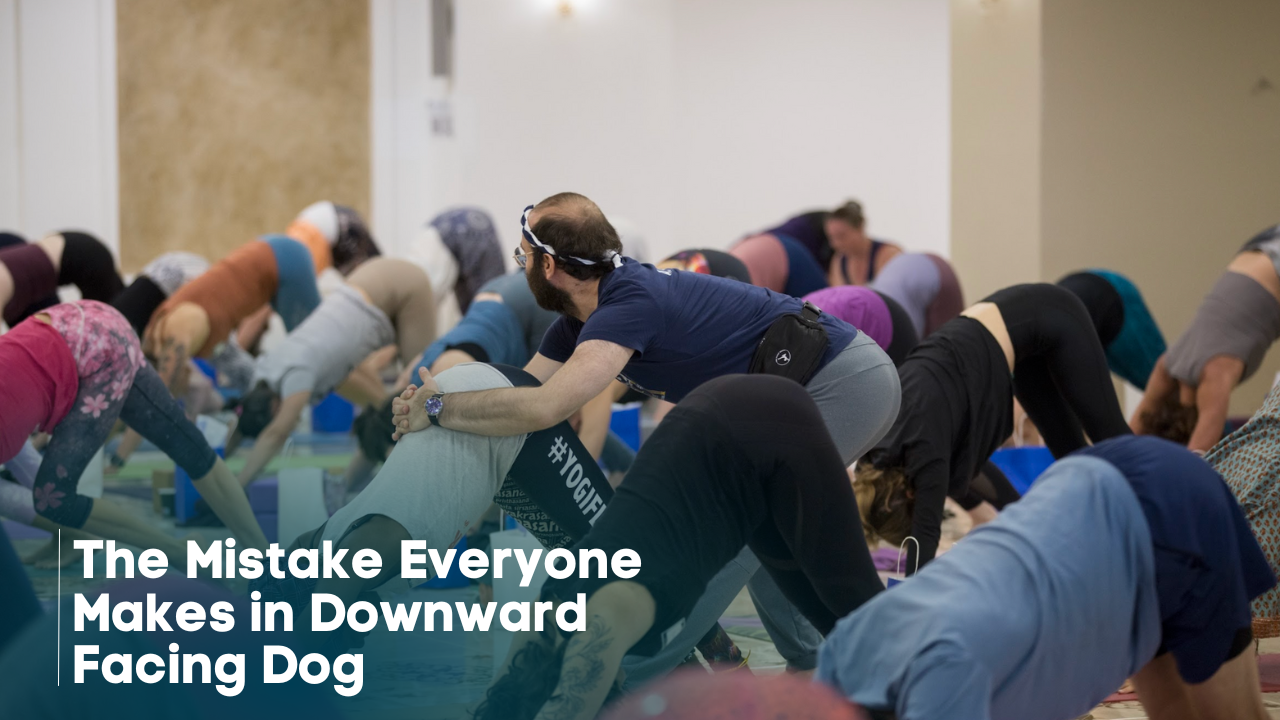The Mistake Everyone Makes in Downward Facing Dog

Ever been in yoga class and heard your teacher say: “Push your heels down to the floor!” as you're moving into Downward Facing Dog?
It’s one of the most common cues...and so many students (and very often, teachers) treat it like the ultimate goal of Adho Mukha Svanasana.
Here’s the problem: forcing your heels to the floor often comes at the expense of the integrity of your spine and shoulders.
For many of us (unless we're cirque du soleil graduates with hamstrings that could reach the moon and back), jamming the heels down causes us to unintentionally round the spine, collapse the shoulders down towards the mat, and (possibly even worse...) takes the purpose out of the pose.
You end up shortchanging the very stretch and strength Down Dog is meant to give you.
The truth? As much as your ego may scream otherwise, touching the floor with your heels isn’t the goal. Not even close.
In this week’s article, we’ll break down why chasing the floor misses the point, how to safely find your version of the pose, and what a truly strong, aligned Down Dog feels like.
So if getting your heels down and stretching the hamstrings to within an inch of their lives isn’t the priority, then what is? The spine.
The integrity of your spine is more important than your heels touching the floor.
In Down Dog, the main goal is to create length from your hands to your hips.
When your spine is long, your shoulders stay strong, your chest opens, and your entire core switches on. This is what makes the pose powerful, effective, and (let’s be real) not the relaxing “resting pose” your yoga teacher may have sold you on.
So how do we find length in the spine? Start with the base: spread your fingers wide (think jazz hands!) and press your hands firmly into the mat. This is a perfect place to practice your Hasta Bandha action (check out part 3 of this blog article here if you're not familiar with the "hand lock").
With the hands engaged, bring attention to the shoulders. Wrap your shoulder blades wide around your ribcage, creating space in your upper back (think: actively pushing the floor away!). Skip this, and your upper back rounds, your chest collapses, and you feel more like a bent-over question mark than a strong, long dog.
Then bend your knees, substantially, if you need to. Yes, your heels will lift off the ground, and that’s perfectly fine. Bending the knees allows you to lift your tailbone toward the ceiling and really find that spinal length. As I like to tell my students: “Imagine you could fart on the ceiling.” (If it happens, it happens, celebrate human bodily functions!)

Don't let your hamstrings dictate what the pose looks like for you
Only once your spine is long and supported do you start thinking about your legs. They do not need to straighten perfectly, and if your hamstrings are tight, keep those knees bent. The yoga police aren't going to appear to whack you in the kneecaps, so give yourself permission to take up the space you need.
Take a quick glance at your feet (even if your toes haven’t seen a pedicure in months). You want to see the tops of your feet, but your heels should stay tucked in line with your legs. If the heels start sneaking out to the side, rotate the thighs slightly to “hide” them behind your legs. Press your thighs back, engage your quads, and internally rotate the legs just a touch.
This active leg engagement creates a strong foundation, so the spine, shoulders, and core can do their work. Down Dog stops being a pseudo “resting pose” and starts doing what it’s meant to do: strengthen your entire body, improve shoulder stability, and safely stretch the hamstrings.
Remember: straightening the legs is optional. You’re building strength, length, and stability, not checking off a yoga Instagram challenge.

Putting it all together
Combine all the elements...fingers pressing, shoulders active, tailbone lifting, legs engaged...and you create a Down Dog that’s long, strong, and fully supported. It’s no longer a pause between poses or a hamstring torture session. It becomes a full-body workout that strengthens, stretches, and challenges.
A properly engaged Down Dog isn’t easy, but it is effective. It trains mindful engagement, preps your body for more advanced poses, and transforms the way you move on your mat. No crumpled posture, no short-changing yourself, just a strong, aligned dog that actually does its job.
Want to see all of this in action?
Check out my YouTube video where I break all of this (and more) down!
And if you want even more guidance, my No Bullsh*t Yoga Pose Library has 90+ yoga poses fully broken down, with modifications, alignment tips, and confidence-building cues. No more guessing. Just clear, actionable instruction so that every pose works for your body.

